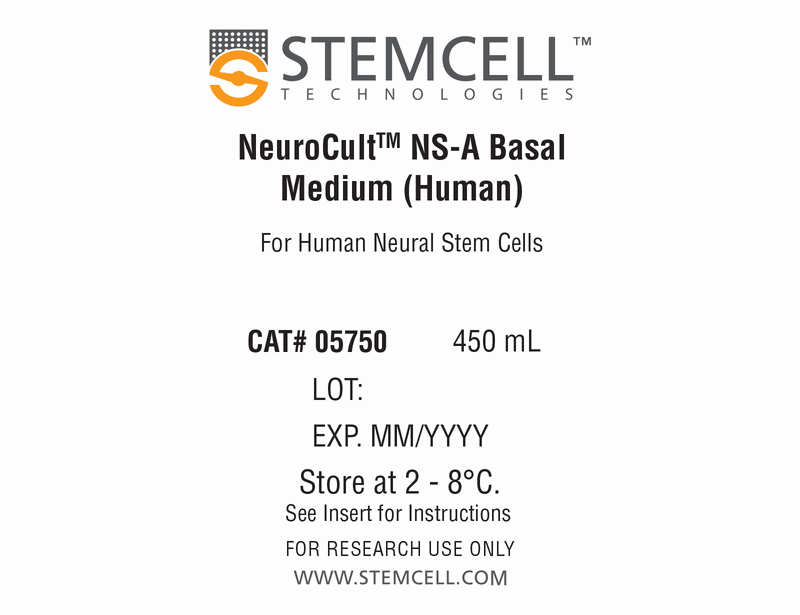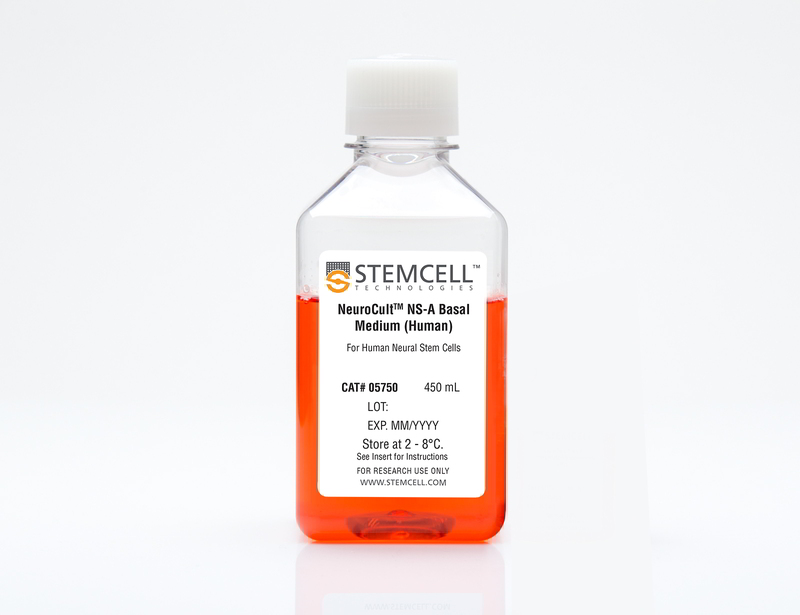NeuroCult™ NS-A Basal Medium (Human)
Basal medium for expansion of human neural stem and progenitor cells
概要
NeuroCult™ NS-A Basal Medium (Human) is a standardized basal medium for the expansion of human neural stem cells and brain tumor stem cells, in the neurosphere or adherent monolayer culture system. This basal medium is a component of the NeuroCult™ NS-A Proliferation Kit (Human; Catalog #05751) and the NeuroCult™ NS-A Differentiation Kit (Human; Catalog #05752).
Subtype
Basal Media, Specialized Media
Cell Type
Brain Tumor Stem Cells, Neural Stem and Progenitor Cells
Species
Human
Application
Cell Culture, Colony Assay, Differentiation, Expansion, Functional Assay, Spheroid Culture
Brand
NeuroCult
Area of Interest
Cancer Research, Drug Discovery and Toxicity Testing, Neuroscience, Stem Cell Biology
Formulation
Serum-Free
技术资料
| Document Type | 产品名称 | Catalog # | Lot # | 语言 |
|---|---|---|---|---|
| Product Information Sheet | NeuroCult™ NS-A Basal Medium (Human) | 05750 | All | English |
| Special Protocol | NeuroCult™ NS-A Basal Medium (Human) | 05750 | All | English |
| Safety Data Sheet | NeuroCult™ NS-A Basal Medium (Human) | 05750 | All | English |
数据及文献
Publications (98)
Viruses 2020 mar
Modelling Lyssavirus Infections in Human Stem Cell-Derived Neural Cultures.
Abstract
Abstract
Rabies is a zoonotic neurological infection caused by lyssavirus that continues to result in devastating loss of human life. Many aspects of rabies pathogenesis in human neurons are not well understood. Lack of appropriate ex-vivo models for studying rabies infection in human neurons has contributed to this knowledge gap. In this study, we utilize advances in stem cell technology to characterize rabies infection in human stem cell-derived neurons. We show key cellular features of rabies infection in our human neural cultures, including upregulation of inflammatory chemokines, lack of neuronal apoptosis, and axonal transmission of viruses in neuronal networks. In addition, we highlight specific differences in cellular pathogenesis between laboratory-adapted and field strain lyssavirus. This study therefore defines the first stem cell-derived ex-vivo model system to study rabies pathogenesis in human neurons. This new model system demonstrates the potential for enabling an increased understanding of molecular mechanisms in human rabies, which could lead to improved control methods.
Nature communications 2020 jul
Single-cell RNA-seq reveals that glioblastoma recapitulates a normal neurodevelopmental hierarchy.
Abstract
Abstract
Cancer stem cells are critical for cancer initiation, development, and treatment resistance. Our understanding of these processes, and how they relate to glioblastoma heterogeneity, is limited. To overcome these limitations, we performed single-cell RNA sequencing on 53586 adult glioblastoma cells and 22637 normal human fetal brain cells, and compared the lineage hierarchy of the developing human brain to the transcriptome of cancer cells. We find a conserved neural tri-lineage cancer hierarchy centered around glial progenitor-like cells. We also find that this progenitor population contains the majority of the cancer's cycling cells, and, using RNA velocity, is often the originator of the other cell types. Finally, we show that this hierarchal map can be used to identify therapeutic targets specific to progenitor cancer stem cells. Our analyses show that normal brain development reconciles glioblastoma development, suggests a possible origin for glioblastoma hierarchy, and helps to identify cancer stem cell-specific targets.
Scientific reports 2019 nov
Higher Order Architecture of Designer Peptides Forms Bioinspired 10 nm siRNA Delivery System.
Abstract
Abstract
The higher-order architecture observed in biological systems, like viruses, is very effective in nucleic acid transport. The replications of this system has been attempted with both synthetic and naturally occurring polymers with mixed results. Here we describe a peptide/siRNA quaternary complex that functions as an siRNA delivery system. The rational design of a peptide assembly is inspired by the viral capsids, but not derived from them. We selected the collagen peptide (COL) to provide the structural stability and the folding framework, and hybridize it with the cell penetrating peptide (CPP) that allows for effective penetration of biological barriers. The peptide/siRNA quaternary complex forms stoichiometric, 10 nm nanoparticles, that show fast cellular uptake ({\textless}30 min), effective siRNA release, and gene silencing. The complex provides capsid-like protection for siRNA against nucleases without being immunostimulatory, or cytotoxic. Our data suggests that delivery vehicles based on synthetic quaternary structures that exhibit higher-order architecture may be effective in improving delivery and release of nucleic acid cargo.
Scientific Reports 2019 dec
BMP signaling mediates glioma stem cell quiescence and confers treatment resistance in glioblastoma
Abstract
Abstract
Despite advances in therapy, glioblastoma remains an incurable disease with a dismal prognosis. Recent studies have implicated cancer stem cells within glioblastoma (glioma stem cells, GSCs) as mediators of therapeutic resistance and tumor progression. In this study, we investigated the role of the transforming growth factor-$\beta$ (TGF-$\beta$) superfamily, which has been found to play an integral role in the maintenance of stem cell homeostasis within multiple stem cell systems, as a mediator of stem-like cells in glioblastoma. We find that BMP and TGF-$\beta$ signaling define divergent molecular and functional identities in glioblastoma, and mark relatively quiescent and proliferative GSCs, respectively. Treatment of GSCs with BMP inhibits cell proliferation, but does not abrogate their stem-ness, as measured by self-renewal and tumorigencity. Further, BMP pathway activation confers relative resistance to radiation and temozolomide chemotherapy. Our findings define a quiescent cancer stem cell population in glioblastoma that may be a cellular reservoir for tumor recurrence following cytotoxic therapy.
Oncogene 2019
BMI1 is a therapeutic target in recurrent medulloblastoma.
Abstract
Abstract
Medulloblastoma (MB) is the most frequent malignant pediatric brain tumor, representing 20{\%} of newly diagnosed childhood central nervous system malignancies. Although advances in multimodal therapy yielded a 5-year survivorship of 80{\%}, MB still accounts for the leading cause of childhood cancer mortality. In this work, we describe the epigenetic regulator BMI1 as a novel therapeutic target for the treatment of recurrent human Group 3 MB, a childhood brain tumor for which there is virtually no treatment option beyond palliation. Current clinical trials for recurrent MB patients based on genomic profiles of primary, treatment-naive tumors will provide limited clinical benefit since recurrent metastatic MBs are highly genetically divergent from their primary tumor. Using a small molecule inhibitor against BMI1, PTC-028, we were able to demonstrate complete ablation of self-renewal of MB stem cells in vitro. When administered to mice xenografted with patient tumors, we observed significant reduction in tumor burden in both local and metastatic compartments and subsequent increased survival, without neurotoxicity. Strikingly, serial in vivo re-transplantation assays demonstrated a marked reduction in tumor initiation ability of recurrent MB cells upon re-transplantation of PTC-028-treated cells into secondary recipient mouse brains. As Group 3 MB is often metastatic and uniformly fatal at recurrence, with no current or planned trials of targeted therapy, an efficacious targeted agent would be rapidly transitioned to clinical trials.
Nature communications 2019
G-quadruplex DNA drives genomic instability and represents a targetable molecular abnormality in ATRX-deficient malignant glioma.
Abstract
Abstract
Mutational inactivation of ATRX ($\alpha$-thalassemia mental retardation X-linked) represents a defining molecular alteration in large subsets of malignant glioma. Yet the pathogenic consequences of ATRX deficiency remain unclear, as do tractable mechanisms for its therapeutic targeting. Here we report that ATRX loss in isogenic glioma model systems induces replication stress and DNA damage by way of G-quadruplex (G4) DNA secondary structure. Moreover, these effects are associated with the acquisition of disease-relevant copy number alterations over time. We then demonstrate, both in vitro and in vivo, that ATRX deficiency selectively enhances DNA damage and cell death following chemical G4 stabilization. Finally, we show that G4 stabilization synergizes with other DNA-damaging therapies, including ionizing radiation, in the ATRX-deficient context. Our findings reveal novel pathogenic mechanisms driven by ATRX deficiency in glioma, while also pointing to tangible strategies for drug development.


